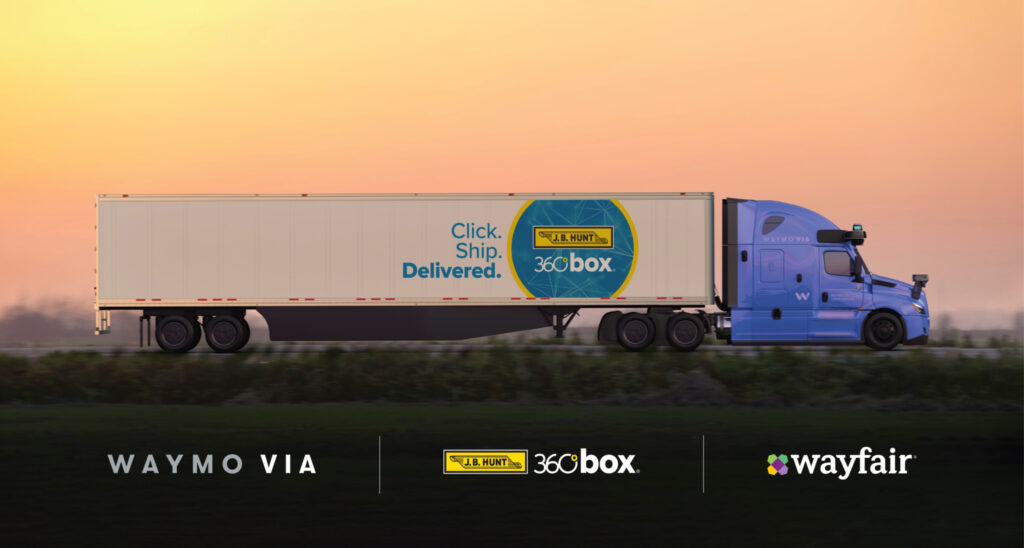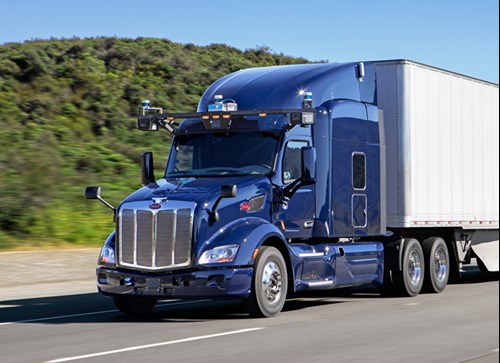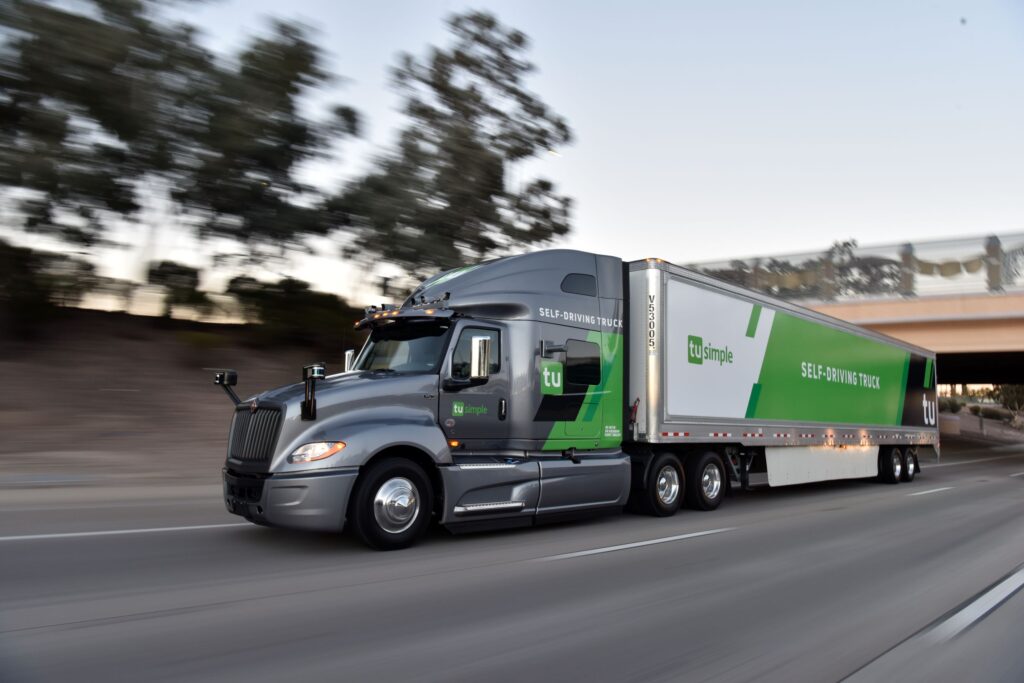Autonomous trucks continue to prove themselves in pilot projects
Craig Harper first presented the idea of autonomous trucks to JB Hunt’s executive team back in 2016, although there wasn’t much to present at the time.
“We couldn’t get a lot of information,” said the fleet’s chief sustainability officer and executive vice-president, during a presentation for ACT Research’s Seminar 67. Many of his own queries during outside discussions were dismissed with phrases like “not in our lifetime.” So he began to reach out to consultants, and added events like the Consumer Electronics Show (CES) to his calendar.
This summer, the concept came a step closer to reality.

Tests with Waymo’s highly autonomous trucks led to a formal strategic alliance with the fleet, and a six-week pilot project saw freight from Wayfair hauled along the I-45 corridor between Houston and Dallas.
“The pilot worked great,” Harper said, noting teams were impressed with the way the technology could identify and respond to roadside hazards and stalled vehicles. “You’re going to see the technology is much more advanced than you may have thought.”
Waymo, which emerged as Google’s self-driving car project in 2009, has been focusing on trucking since 2017 through Waymo Via. And the trucks themselves are clearly more advanced than a typical tractor.
“You can’t go out there any buy a Class 8 truck with all the relevant redundancies,” explained John Verdon, who oversees business development and partnerships at Waymo. There are more than 1,500 functional requirements involved in producing the highly autonomous Level 4 vehicles that can handle most driving tasks independently.
But through a partnership with Daimler Truck, Waymo is now launching highly autonomous Freightliner Cascadias into the market, complete with a sensor suite that incorporates lidar, radar and cameras to sense the world around them.
The autonomous performance in the JB Hunt project has been strong, Verdon said, referring to things like consistent lane centering and speed profiles compared to human benchmarks.

Value propositions
Alan Ghelberg, Aurora’s vice-president – corporate strategy, sees trucking as a perfect fit for the autonomous vehicles like those being developed by his company. “The value proposition is incredibly compelling,” he said.
An autonomous load running from Los Angeles to Houston, for example, could conceivably be completed in a single day because there would be no limits on Hours of Service. Then there are the fuel savings that can come from better-managed speeds and a bigger share of trips completed off hours.
There are limits, of course. “Three shifts a day is a lot of dreaming. We would love to run trucks three shifts a day, but there’s a problem – the shippers and receivers aren’t open,” Harper said. But such trucks would still be more productive. Much more.
There are potential safety benefits, too. “Things like human factors, distraction, drowsiness, fatigue are attributed to over 90% of accidents, and an autonomous truck doesn’t get tired,” Ghelberg said.
The potential benefits have led to partnerships with companies including FedEx, Werner, US Xpress, Schneider, Uber Freight, and Covenant Logistics.
“The goal of those partnerships is to plan, pilot,” he said.

Lower operating costs?
Srinivas Gowda, Navistar’s vice-president – autonomous driving, listed several operational benefits that could be realized through everything from enhanced fuel-saving strategies to the eventual ability to remove drivers from the cab – ultimately lowering operating costs by up to 40% when compared to conventional trucking.
Autonomous vehicles wouldn’t replace human drivers everywhere and in every case. Early pilot projects are focusing on terminal-to-terminal highway moves. But they could change the nature of the job.
“It also gives time back to the driver so they can spend more time back at home with their families,” Gowda said.
There could even be maintenance benefits. Trucks that travel more miles will wear individual components more quickly, but autonomous systems can be programmed to run exacting speeds and rpms to deliver other potential benefits like better oil drain intervals. “That truck doesn’t have a bad day or get mad,” Harper said.
And there would be no need to address issues relating to driver comfort, such as squeaky seats, worn mattresses, or static on the radio, he added. “You won’t have to equip the truck in the same manner.”
Questions to answer
There are still plenty of questions to answer, though. For example, it’s still unknown who would conduct pre-trip and post-trip inspections if drivers were completely removed from the equation.
“How are we going to use this? What’s it going to solve for our customer?” Harper said, referring to operation-related questions that need to be considered. “Is it short length of haul bouncing back and forth as quickly as you can, or is it from depot to depot?” Maybe drayage operations would be a good fit.
“It is a lot more than just carrying freight,” Verdon said, referring to underlying questions around how scheduling will work.
Gowda points to data-related needs as another example.
“The whole data management exercise comes at a cost,” he said. How will it ultimately need to be managed and stored? “Is it on the truck? Is it on the cloud?”
Then there’s the issue of how autonomous vehicles would fit into service networks. If a truck signals a need for help, those sitting behind a computer in a control tower will need to understand the best course of action.
Barriers that remain
There are non-technical barriers outside the trucking industry to overcome as well. Teamsters and railways could push against plans for autonomous trucks as the driverless vehicles compete for intermodal business, Gowda said.
Other potential challenges fall into what he calls “undecided” territory. Public safety groups may support the technology if they’re satisfied with safety standards. The general public, meanwhile, will need to be comfortable sharing the road with autonomous vehicles. Small shippers and fleets likely won’t adopt the technology at first because of initial costs. And support within various state agencies can be influenced by local politics.
For now, JB Hunt is looking to conduct more pilot projects, as it explores which lanes and freight would offer the best fit. “We’ve talked to virtually all of the autonomous players,” Harper said, when asked if the fleet was working with more than Waymo alone. “We do rely heavily on OEMs and work with them.”
“Partnership is probably the underlying foundation for this. We can’t do this alone,” Gowda said, referring to Navistar’s own partnership with TuSimple. The latter company is responsible for things like developing and validating sensor suites, as well as aftermarket software updates, high-definition mapping, and ongoing technical support.
A southern focus
Initial Waymo rollouts will focus on runs between Dallas to Houston and then expand through the southwest U.S., Verdon said.
“This isn’t going to be a ubiquitous launch everywhere,” Ghelberg agreed, referring to Aurora’s own plans to launch commercially in Texas in 2024. “This isn’t going to be a Big Bang all at once.” Early expansion plans will be through the sun belt, even though a majority of U.S. states permit self-driving technology to be deployed one way or another.
“It doesn’t make sense for us to start with snowy weather,” he said. But the goal is to continue a northward march. “Eventually.”
Gowda expects the first rollouts along the I10 highway corridor in the southern U.S., beginning with large fleets in 2030. But he sees the long-term potential of 1 million level 4 autonomous trucks after 2035.
“Autonomy will not happen overnight. It’s a long-term game,” Gowda said.
Harper doesn’t believe the technology will replace truck drivers outright. Overall freight volumes are growing too quickly for that. There are 3.2 million trucks on U.S. roads today, and 4.1 million will be needed by 2035, he said. Even if 400,000 autonomous trucks were on the road by the latter year, an estimate from Roland Berger consultants, that would still leave more human driving jobs than exist today.
“If you’re a driver today,” Harper said, “you’re going to be able to retire a driver.”
Have your say
This is a moderated forum. Comments will no longer be published unless they are accompanied by a first and last name and a verifiable email address. (Today's Trucking will not publish or share the email address.) Profane language and content deemed to be libelous, racist, or threatening in nature will not be published under any circumstances.